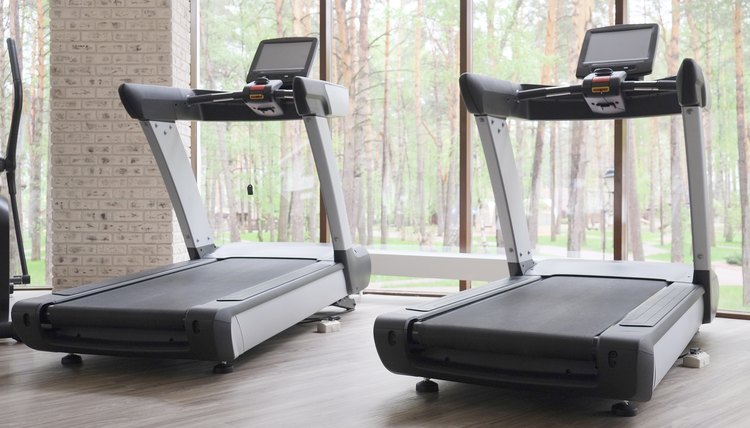Why Does My Treadmill Keeps Stopping & Starting?

Treadmills hold up to extreme use if well designed. But breakdowns can result if users exceed the weight limits or don't perform the necessary maintenance. Simple problems might explain unwanted starting and stopping of a treadmill during workouts. Unexplained stops might also signal serious trouble. Consult the owner's manual for trouble-shooting advice before calling in technicians. The answer might be free.
Overheating
Inexpensive treadmills cannot carry as much load as heavy-duty models, so check weight capacity before purchase. Signs of overheating include unusual hot oil odors or the smell of burning plastic. Overheating trips a circuit breaker on most treadmills, stopping the motor before severe damage occurs. Some machines reset when the motor cools, but often a manual reset is required before the treadmill starts again. Circuit breaker switches should be easily accessible near the motor. Tripping the breaker repeatedly indicates a serious problem, but the solution might be as simple as cleaning lint from the cooling vents. Keep the motor housing clear of folded mats, extra clothing or anything else that might block airflow.
Belt Adjustment
If the edge of the belt rubs against the side of the treadmill, that puts extra strain on the motor. Unusual noise or a frayed belt edge makes this problem obvious, but other belt issues might be harder to spot. Owner's manuals list lubrication needs for bearings and belts. Skipping maintenance increases the friction load. Placing the treadmill in a dusty area quickly clogs the belt with dirt and grit and intensifies the trouble. Regular cleaning and lubrication becomes as important to machine life as correct adjustment.
Key Types
Every treadmill must include a safety key switch. Runners and walkers clip the end of the key's cord to clothing or belt to ensure the treadmill stops if the user falls. Safety switch types range from magnets to pressure keys. As any switch ages, reliability decreases. Intermittent operation might be temporarily fixed by removing the key and re-inserting. Burned or oxidized contacts require replacement by a qualified technician.
Power Considerations
A good technician checks the power cord first. The reason a treadmill starts and stops unpredictably might be as simple as a power plug that doesn't make reliable contact with the wall outlet. Jiggling the plug while in the wall outlet should reveal whether this causes the trouble. Pulling the plug out and spreading the prongs slightly wider before re-inserting could fix the issue. But if the plug won't fit and problems continue, an electrician could install a new wall outlet.
Fuses also cause intermittent power failures since contacts build up insulating oxides over time. Check the manual for the machine's fuse location and type, and disconnect the power cord before inspecting the fuse and fuse box. Replace the fuse to be sure it isn't the root of the problem. Visual inspection won't always reveal the fault.
Electronics Creep
Advanced treadmills run exercise programs that automatically vary speed or inclination. The internal computer that controls speed and sets the platform to the required angle depends on electrical contacts to activate motors in the treadmill. Through a process technicians refer to as "creep" -- expansion and contraction due to heating and cooling -- circuit boards and chips may dislodge from sockets. Failures because of creep could be intermittent, causing system startups followed quickly by shutdowns. Qualified technicians service these problems.
References
Writer Bio
James Young began writing in 1969 as a military journalist combat correspondent in Vietnam. Young's articles have been published in "Tai Chi Magazine," "Seattle Post-Intelligencer," Sonar 4 ezine, "Stars & Stripes" and "Fine Woodworking." He has worked as a foundryman, woodturner, electronics technician, herb farmer and woodcarver. Young graduated from North Seattle Community College with an associate degree in applied science and electronic technology.
